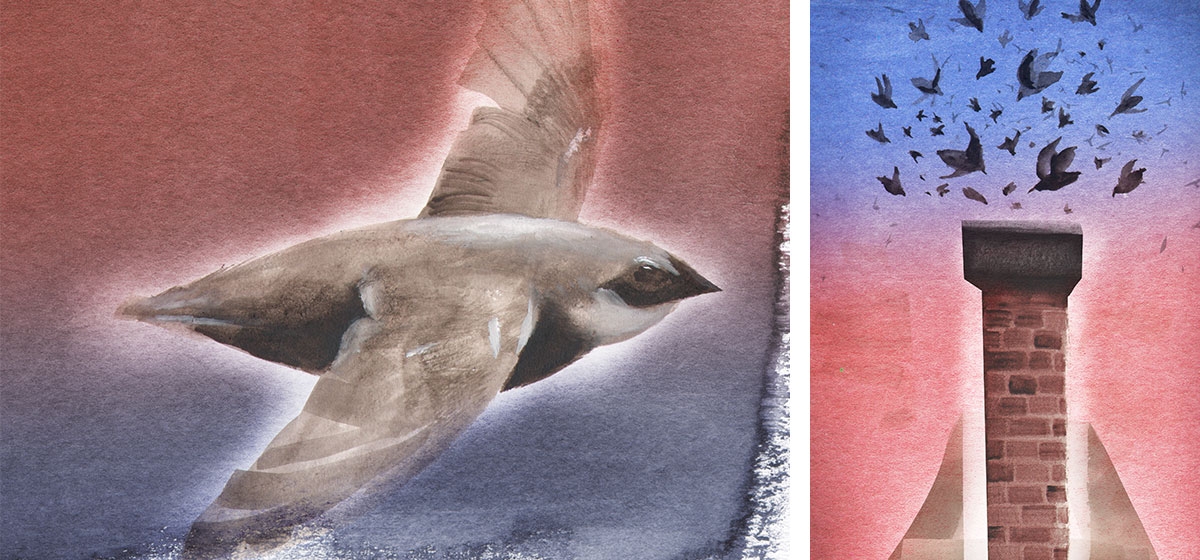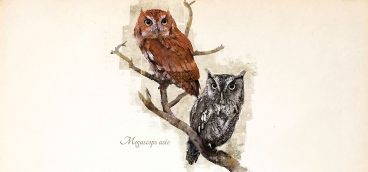
“But one day the swifts are back. Face to the sun like a child
You shout, ‘The swifts are back!’ ”
—from “Swifts,” by Anne Stevenson
At first I thought they were bats, and I was thrilled because bats are nearly nonexistent on our farm now. But something wasn’t quite right. How high they flew. The sounds they made. Barn swallows maybe? But swallows dart in and out of our outbuildings all day; they don’t just fly near the farmhouse at dusk. Indeed, these little five-inch birds were neither bats nor swallows, but chimney swifts.
A few swooped out of the sky toward the house each night late last summer while my husband and I ate dinner on the porch. We heard them before we saw them. More arrived, then what seemed like hundreds, chirping loudly. They circled the chimney, and like fighter jets landing on aircraft carriers, tried to position themselves just right. Some hit the entrance on the first try, but others aborted and took another pass.
I stood and watched them. Round and round they went, a funnel cloud of hundreds of birds, at that moment between light and darkness, when the pines are backlit against a fading sky. Later, walking across the lawn after closing the chicken coop, I noticed six swifts still circling, then three; all but one had made it into the chimney. I heard the rise of the nighttime chorus of bullfrogs, katydids, and crickets, and by the time I saw the evening star and the lightning bugs glowed around the apple trees, all the swifts were tucked in safely for the night.
And tucked in they were—into our uncapped, unlined, 19th-century stone flue—the perfect spot for chimney swifts. They are unusual birds in so many ways: they bathe on the wing, do not roost in trees, seldom touch the ground, and cannot perch like normal birds; instead they cling to vertical surfaces with their claws. Brownish gray with pale throats, stubby necks, and short, square tails, they have long curved wings that cross an inch or so at their tail feathers, and when stretched out have a wingspan of about 12 inches.
Roger Tory Peterson called them “a cigar with wings.” Males and females are identical in appearance and there’s equality in the chimney swift world as each takes responsibility for rearing the young. “There’s a rule of thumb with birds,” said Jim Bonner, executive director of the Audubon Society of Western Pennsylvania. “The more the male and female look alike, the more they share the nesting duties.” During breeding season, which takes place in our area from May to July, chimney swifts build cup-shaped nests of small twigs glued together with saliva. Only one nesting pair is allowed in a chimney during that time, though they occasionally accept other non-breeding birds, which may act as nannies to help raise the chicks.
Years ago—when these birds were called American Swifts—they nested in vertical surfaces such as cliffs, caves, and hollow old-growth trees, but the clearing of forests made such spots scarce. They began roosting instead in man-made structures such as chimneys, and in the late 19th century their name was changed. Now these little acrobats have new problems: houses are built without chimneys, or chimneys are capped or lined with metal, making it impossible for the birds to grab hold of the sides. In the last 50 years, their population has declined 72 percent nationwide and 52 percent in Pennsylvania, and in 2010 The International Union for Conservation of Nature classified them as “near threatened.”
Chimney swifts are often killed inadvertently or purposely by homeowners and chimney sweeps, and while they’re protected by the Migratory Bird Treaty Act—the hundredth birthday of which was in 2018—that treaty is currently being threatened by the Trump administration. With this in mind, and since swifts often mate for life and return to the same spot each year, my husband and I decided we’d allow them continued use of our chimney. Our house is now theirs.
Other factors have contributed to the bird’s decline, such as fewer native plants and a decrease in bugs due to pesticides. Fewer bugs could really matter to birds that spend all day on the wing eating 5,000-6,000 insects a day, including gnats, fleas, moths, mayflies, mosquitoes and beetles. Still, according to Luke DeGroote, avian research coordinator at Powdermill Nature Reserve, “We don’t have a good understanding of the diet of adult birds.” Powdermill is planning a study on how diet, landscape and pesticides affect chimney swifts. He cited a report, published last October, showing that 76 percent to 82 percent of insects in Germany have declined in the last 27 years and said ornithologists are worried how this will affect aerial insectivores, “a hot topic now,” he told me.
Ornithologists know surprisingly little about this mysterious bird. The birds’ “daily elevation profile not known,” states Cornell’s Birds of North America website. We don’t really know how they choose roosting sites, exactly how they forage, or where precisely they winter. They’re difficult to study because of their aerial behavior, because they nest in such enclosed places, and “they’re quick, small, and travel in flocks,” DeGroote said. “That makes it difficult to track any individual bird without technology.” Powdermill will use new technology called nanotags to better understand the birds.
Why should we care about chimney swifts? I asked Jim Bonner of Audubon: “We care on different levels and for different reasons,” he said. “It’s the ethics and importance of protecting any living creature that makes up our ecosystem. We care about ourselves. It’s an overused cliché, but they are the canaries in the coal mine. On another level, they’re just great birds, fun, playful, beautiful to watch and there’s something very special about a bird that returns each summer from South America to share our homes with us.”
Mary F. Day, an early observer of chimney swifts, would have likely agreed. In her 1899 article, “Home Life in a Chimney” published in Bird Lore Magazine, she wrote about observing nesting swifts in her New Jersey home by placing a mirror in the chimney and watching the birds through a stovepipe opening covered with black fabric. “Although the room was used as a bedchamber throughout the summer the swifts never seemed to be annoyed by the close proximity of their human neighbors,” she wrote. “They were of a trustful disposition and soon became accustomed to being watched.”
Women, it seems, championed the tiny bird in the early years. Men did too, of course, but it was the perfect union between women and birds. Chimney swifts came out of the woods and landed into the homes of smart, curious, and bird-loving 19th and early 20th century women. Althea R. Sherman was another. She wrote “Birds of an Iowa Dooryard,” and in 1915 designed and had built the first chimney swift’s tower—wooden, 28-feet tall, 9-feet-square, with windows, doors, peep holes, and a three-story staircase. Her “Chimney Swift Journals” comprised more than 400 pages of handwritten notes and are “the basis of everything we now know about what she called ‘the home life of the chimney swift,’ ” wrote Paul and Georgean Kyle in “Chimney Swifts: America’s Mysterious Birds Above the Fireplace.” The Kyles also run the Chimney Swift Conservation Association in Austin, Texas, “our effort to draw attention to the plight of these highly beneficial yet often maligned birds,” Georgean Kyle said.
Jim Bonner called Althea Sherman “one of many women who have been instrumental in driving avian research and conservation—many of whom are not known to the public.” Yet another woman, Margaret Whittemore (1897-1983), observed chimney swifts, raised orphaned birds and wrote “Chimney Swifts and their Relatives,” a seminal book on the subject.
I have neither built a chimney, conducted scientific research, nor raised any orphans. I’ve only observed chimney swifts on a western Pa. farm. But it’s nice to feel part of this long line of women who care about birds. Last autumn, I paid close enough attention to know that my chimney swifts had departed by September 20, when they signaled to each other that it was time to gather together and migrate en masse to Ecuador, Peru, Chile or Brazil. Maybe Colombia. Georgean Kyle said that in Texas in March, “large roosts can be seen” as the birds migrate north to breed and nest. Our chimney swifts will be back in our area by April where apparently the roost is not as large, but you can be sure I’ll be looking out for them, awaiting their return, keeping the chimney clear.





